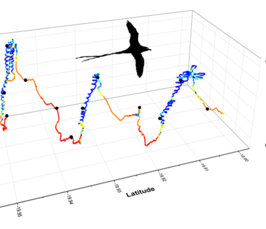Institute Seminar - Adwait Deshpande & Richard Gunner
Institute Seminar by Adwait Deshpande & Richard Gunner
- Datum: 10.05.2022
- Uhrzeit: 10:30 - 11:30
- Vortragende(r): Adwait Deshpande & Richard Gunner
- Ort: online
- Raum: Online
- Gastgeber: Max Planck Institute of Animal Behavior
- Kontakt: all.science@ab.mpg.de

Social learning and flexibility in vocal communication of wild vervet
monkeys (by Adwait Deshpande) +
A day of true reckoning; elucidating animal movement vectors sheds light on space-use, navigation and decision-making (by Richard Gunner): Understanding what animals do in time and space is important for a range of ecological questions, including movement-specific behavioural strategies, resource selection and networks of space-use. Animal-attached devices conventionally use VHF transmitters or GPS devices to verify an animal’s location. The quality of interpolations between these ‘Verified Positions’ (VPs) depending on the temporal- and spatial resolution of the system. This affects a variety of factors of ecological interest such as estimates of distance travelled, route-taken and space-associated behaviours. Many biologging studies pair GPS with motion sensors, such as accelerometers to resolve activity-specific behaviours more finely. Dynamic acceleration is a critical dimension of movement and has been examined extensively, however another dimension of movement, and fundamental aspect of animal behaviour, is body rotation. The overarching question of my PhD was; ‘What does animal rotation tell us about behaviour?’ One powerful, yet sparingly utilised technique that requires estimates of body rotation is ‘dead-reckoning’, which integrates estimated vectors of travel (heading and speed), derived from sensor-borne estimates in 2-D or 3-D (pressure/pitch) space. Dead-reckoning can provide the means of “filling out” the missing space-time-use information and can provide critical information between VPs. Here, I discuss some of the key results of my PhD: Firstly, I show how angular velocity metrics can help assess activity extent and exemplify behaviours using the loggerhead turtle (Caretta caretta) as a model species. I then go on to demonstrate how dead-reckoning can highlight specific behaviours, orientation strategies and use of space within ‘energy landscapes’. This includes examination of the movement strategies of Magellanic penguins (Spheniscus magellanicus) as they navigate on land and at sea, and barrier transgression movements of lions (Panthera leo). Lastly, I go on to discuss the aims of my current research, to investigate the utility of dead-reckoning on arboreal species in order to resolve 3-D space-use in a lattice-framework of movement-facilitating trails.